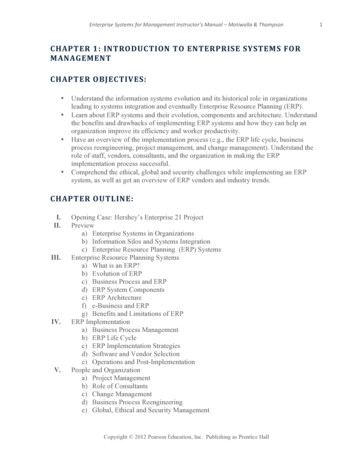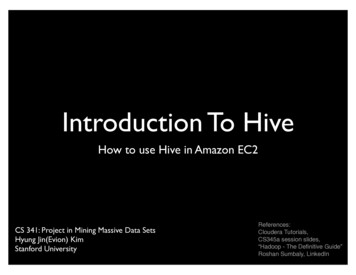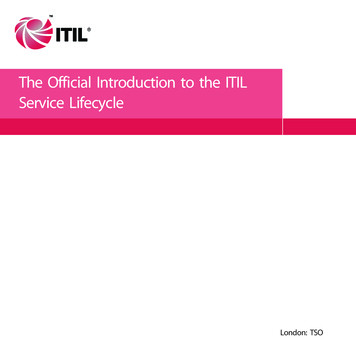
Transcription
Introduction to XSLMax Froumentin - W3C Introduction to XSLXML DocumentsStyling XML DocumentsXSLExample I: HamletExample II: Mixed Writing ModesExample III: databaseOther ExamplesHow do they do that?The XSL Process(es)Server-Side/Client-Side XSL XSL and other W3C specsTransformations: XSLTGeneral-purpose XSLTTemplatesXSLT statements"Play" to HTMLXPathFormatting Objects basicsPagesThe area modelBlock/inline areas
Introduction to XSLMax Froumentin - W3C Formatting Objects:PropertiesExample: Play to FOTop-level TemplateI18N Formatting Objects andProperties Other Formatting Objects Example: mixed writing modes If you are still interested.
Introduction to XSLIn a nutshell: XSL is a W3C specification that describes a methodfor visually presenting XML documents.This tutorial will cover: An overview of the XSL spec (including XSLT and XPath) Examples of various use cases Relationship with other XML technologies A detailed exampleThese slides are available uction to XSLMax Froumentin - W3C1 of 30
XML Documents XML (eXtensible Markup Language) adds information to textfiles, using tags and attributes [example1], [example2] Tag names are defined for a specific document type. Uses the Unicode character set Designed to be easily processed by machine while remainingreadable.Introduction to XSLMax Froumentin - W3C2 of 30
Styling XML Documents XML documents are ideally semantic. For example, this bit ofHTML is wrong:Do not strong smoke /strong , it eat /it or blink drink /blink in this room. Presentation data should be separate Two solutions for styling: CSS (Cascading Style Sheets) andXSL (eXtensible Stylesheet Language).CSSTITLE {display: block;font-family: Helvetica;font-size: 18pt}Simple model: properties are associated to tags or attributes.Introduction to XSLMax Froumentin - W3C3 of 30
Introduction to XSLMax Froumentin - W3C3 of 30
XSLXSL is an alternative to CSS that allows greater control over thepresentation of the XML data.What can it do? [like CSS] allow changing presentation without changing theXML source, and display documents on various media, also: I18N features (writing modes, text alignment,hyphenation), complex page layout, footnotes, automaticgeneration of content (index)Who is it for?Applications that require high-level quality formatting: Publishing industry (books, technical documentation)Introduction to XSLMax Froumentin - W3C4 of 30
Publication on different media: paper, web, mobile devices .But is it not meant to be used where presentation is deeply tied tothe contents (like graphic design).Introduction to XSLMax Froumentin - W3C4 of 30
Example I: Hamlet ACT SCENE TITLE A room in the castle. /TITLE STAGEDIR Enter KING CLAUDIUS, QUEEN GERTRUDE,POLONIUS, OPHELIA, ROSENCRANTZ, andGUILDENSTERN /STAGEDIR SPEECH speaker "King Claudius" LINE And can you, by no drift of circumstance, /LINE LINE Get from him why he puts on this confusion, /LINE LINE Grating so harshly all his days of quiet /LINE LINE With turbulent and dangerous lunacy? /LINE /SPEECH .Formatted for paper output (PDF), formatted for the Web (XHTML)Introduction to XSLMax Froumentin - W3C5 of 30
Example II: Mixed Writing ModesIntroduction to XSLMax Froumentin - W3C6 of 30
Example III: database. record year "1992" artist Sundays, The /artist title Blind /title /record record year "1994" artist (Various) /artist title The Glory of Gershwin /title note Compilation /note /record record type "soundtrack" year "1992" artist Kamen, Michael /artist title Brazil /title location folder "3" page "20"/ /record .PDFIntroduction to XSLMax Froumentin - W3C7 of 30
Other Examples W3C specs (one DTD, output formats: HTML, sliced HTML,text, PDF), e.g MathML 2.0, XML 1.0 This slideshowIntroduction to XSLMax Froumentin - W3C8 of 30
How do they do that? An XSL stylesheet is an XML File It is associated to an XML document with a StylesheetProcessing Instruction (like CSS) ?xml-stylesheet ref "shakespeare.xsl" type "text/xsl"? ACT SCENE TITLE A room in the castle. /TITLE The actual formatting is performed either off-line or on thebrowserIntroduction to XSLMax Froumentin - W3C9 of 30
The XSL Process(es)The result tree is an XML document in which the markup hasinformation about how to display the document: what font to use,the size of a page, etc. This markup is called Formatting ObjectsIntroduction to XSLMax Froumentin - W3C10 of 30
(elements) and Properties (attributes). For example: block font-family "Helvetica" ACT III /block block font-size "10pt" Scene 1: A room in the castle /block block space-before "10mm" font-style "italic" Enter KING CLAUDIUS, QUEEN GERTRUDE, POLONIUS,OPHELIA, ROSENCRANTZ, and GUILDENSTERN /block .Generated from: ACT SCENE TITLE A room in the castle. /TITLE STAGEDIR Enter KING CLAUDIUS, QUEEN GERTRUDE,POLONIUS, OPHELIA, ROSENCRANTZ, andGUILDENSTERN /STAGEDIR .Introduction to XSLMax Froumentin - W3C10 of 30
Server-Side/Client-Side XSL Off-line (e.g. for printing) Server-side:server transforms, client renders (not recommended) Client-side:client transforms and renders (allows user styles)Introduction to XSLMax Froumentin - W3C11 of 30
XSL and other W3C specsXSL uses CSS properties to express formattinginformation, and uses the CSS inheritance model. CSS:TITLE {display: block;font-family: Helvetica;font-size: 14pt;} XSL: xsl:template match "TITLE" fo:block font-family "Helvetica" font-size "14pt" [.] /fo:block /xsl:template XSL and SVG, MathML XSL can import images and other types of known XMLIntroduction to XSLMax Froumentin - W3C12 of 30
documents: SVG and MathML. Up to the renderer to handle other namespacesIntroduction to XSLMax Froumentin - W3C12 of 30
Transformations: XSLTXSLT is a transformation language originally designed to transformany XML document into another XML document containingformatting objects: pages, blocks, graphics, text, etc.Introduction to XSLMax Froumentin - W3C13 of 30
General-purpose XSLTXSLT has evolved to become a general-purpose transformationlanguage from XML to XML.Many users use it to transform their own XML document type toHTML for viewing within a browser XSLT stylesheets use XML syntax A stylesheet is a list of templates ?xml version "1.0" encoding "utf-8"? xsl:stylesheet xmlns:xsl "http://www.w3.org/1999/XSL/Transform"version "1.0" xsl:template match "/" . /xsl:template xsl:template match "/html" . /xsl:template /xsl:stylesheet Introduction to XSLMax Froumentin - W3C14 of 30
Templates Each template applies to a type of nodes in the inputdocument When matches are made, the templates contains desiredoutput. xsl:template match "TITLE" fo:block font-family "Helvetica" font-size "14pt" xsl:apply-templates/ /fo:block /xsl:templates So this will transform: TITLE Hamlet /TITLE into fo:block font-family "Helvetica" font-size "14pt" Hamlet /fo:block Introduction to XSLMax Froumentin - W3C15 of 30
HTML can also be generated very simply in the template, using forinstance h1 instead of fo:block xsl:apply-templates/ means: apply other templates tocontents.Implicit rule: text is copied from input to output: a style sheet with norules will only return the character data of the input.Introduction to XSLMax Froumentin - W3C15 of 30
XSLT statementsAllow navigation and iteration within the input document tree xsl:value-of select "."/ Gets a value (node contents or attribute) from the input tree. xsl:for-each select "." Loops over the nodes in the select expression xsl:if test "." . /xsl:if ConditionalIntroduction to XSLMax Froumentin - W3C16 of 30
"Play" to HTMLVery simple one-template example using the 'pull' method: ?xml version "1.0" encoding "utf-8"? html xmlns "http://www.w3.org/1999/xhtml"xmlns:xsl "http://www.w3.org/1999/XSL/Transform"xsl:version "1.0" head title xsl:value-of select "PLAY/TITLE"/ /title /head body h1 xsl:value-of select "PLAY/TITLE"/ /h1 xsl:for-each select "PLAY/ACT" xsl:for-each select "SCENE" xsl:if test "TITLE" h2 xsl:value-of select "TITLE"/ /h2 /xsl:if xsl:for-each select "SPEECH" h3 style "color: red" xsl:value-of select "SPEAKER"/ /h3 xsl:for-each select "LINE" p xsl:value-of select "."/ /p /xsl:for-each /xsl:for-each /xsl:for-each /xsl:for-each Introduction to XSLMax Froumentin - W3C17 of 30
/body /html Result: ?xml version "1.0" encoding "utf-8"? html xmlns "http://www.w3.org/1999/xhtml" head title The Tragedy of Hamlet, Prince of Denmark /title /head body h1 The Tragedy of Hamlet, Prince of Denmark /h1 h2 Elsinore. A platform beforethe castle. /h2 h3 style "color: red" BERNARDO /h3 p Who's there? /p h3 style "color: red" FRANCISCO /h3 p Nay, answer me: stand, and unfold yourself. /p .Extended, output: numbering, TOC, etc.This uses the 'push' method where structure follows the input.Introduction to XSLMax Froumentin - W3C17 of 30
"Play" to HTMLRoughly there is one template for each tag type in the inputIntroduction to XSLMax Froumentin - W3C17 of 30
XPath . is another W3C specification; an expression language to selects parts of an XML documenttree; is used in xsl:template match "." or xsl:value-of select "." , etc.; and can be as simple as TITLE, or as complex as/ACT[3]/SCENE[position() < 5and position() >2]/SPEAKER[@name "Hamlet"]/LINE[contains(.,"shoe box")]Introduction to XSLMax Froumentin - W3C18 of 30
Formatting Objects basics the FO vocabulary is one special type of output from XSLT FOs are organized as an XML tree: Each node has associated properties, either directlyspecified (by attributes) or inherited.Introduction to XSLMax Froumentin - W3C19 of 30
Pages A page is divided in 5 regions: body, before, after, start andendIntroduction to XSLMax Froumentin - W3C20 of 30
The area modelOn the page will be layed out areas, that contain text, images andother areas. An area is a rectangle, with padding and border:Introduction to XSLMax Froumentin - W3C21 of 30
Block/inline areasThe concept of relative orientation and writing-modes. Where CSSdefines top, bottom, left, right, XSL adds before, after, start andend. Areas can be of type: block or inline. Blocks are stacked fromthe 'before' side to the 'after' side, inlines are stacked orthogonally.Introduction to XSLMax Froumentin - W3C22 of 30
Formatting Objects: Define the quence Generate areasfo:blockfo:inlinefo:character n to XSLMax Froumentin - W3C23 of 30
Properties Each area has a set of traits: color, background, font-size,etc. Areas are inherited down the FO tree using the CSSinheritance model They are specified in the source as attributes associated toFormatting Objects. fo:block font-family "Helvetica" font-size "14pt" This is Helvetica 14pt text. fo:block font-size "200%" This is Helvetica 28pt text. /fo:block /fo:block Introduction to XSLMax Froumentin - W3C24 of 30
Example: Play to FO ?xml version "1.0" encoding "utf-8"? xsl:stylesheetxmlns:xsl "http://www.w3.org/1999/XSL/Transform"xmlns:fo "http://www.w3.org/1999/XSL/Format"version "1.0" !-- ********** -- xsl:output method "xml" indent "yes"/ xsl:template match "/" xsl:apply-templates/ /xsl:template xsl:template match "*" xsl:apply-templates/ /xsl:template xsl:template match "PLAY" fo:root fo:layout-master-set fo:simple-page-master master-name "title-page"page-width "210mm" page-height "297mm"margin-top "2cm" margin-bottom "2cm"margin-left "2cm" margin-right "2cm" fo:region-body region-name "body"/ /fo:simple-page-master fo:simple-page-master master-name "act-page"page-width "210mm" page-height "297mm"margin-top "2cm" margin-bottom "2cm"Introduction to XSLMax Froumentin - W3C25 of 30
margin-left "2cm" margin-right "2cm" fo:region-body region-name "body" margin-top "1cm"margin-bottom "1cm"/ fo:region-before extent "1cm" region-name "header"/ fo:region-after extent "1cm" region-name "footer"/ /fo:simple-page-master /fo:layout-master-set fo:page-sequence master-name "title-page" fo:flow flow-name "body" fo:block display-align "center" xsl:apply-templates select "TITLE"/ xsl:apply-templates select "FM"/ /fo:block /fo:flow /fo:page-sequence fo:page-sequence master-name "title-page" fo:flow flow-name "body" fo:block space-before "5cm" fo:block font-size "16pt" space-after "3em"text-align "center" xsl:text Table of Contents /xsl:text /fo:block fo:block start-indent "3cm" font-size "14pt" xsl:apply-templates select "ACT" mode "toc"/ /fo:block Introduction to XSLMax Froumentin - W3C25 of 30
Example: Play to FO /fo:block /fo:flow /fo:page-sequence fo:page-sequence master-name "title-page" fo:flow flow-name "body" xsl:apply-templates select "PERSONAE"/ /fo:flow /fo:page-sequence fo:page-sequence master-name "title-page" fo:flow flow-name "body" xsl:apply-templates select "SCNDESCR"/ /fo:flow /fo:page-sequence xsl:apply-templates select "ACT"/ /fo:root /xsl:template xsl:template match "PLAY/TITLE" fo:block text-align "center"font-size "30pt"space-before "1em"space-after "1em" xsl:apply-templates/ /fo:block /xsl:template xsl:template match "TITLE" Introduction to XSLMax Froumentin - W3C25 of 30
fo:block text-align "center"font-size "20pt"space-before "1em"space-after "1em" xsl:apply-templates/ /fo:block /xsl:template xsl:template match "ACT/TITLE" fo:block id "{generate-id()}"text-align "center"font-size "20pt"space-before "1em"space-after "1em" xsl:apply-templates/ /fo:block /xsl:template xsl:template match "SCENE/TITLE" fo:block text-align "center"font-size "16pt"space-before "1em"space-after "1em" xsl:apply-templates/ /fo:block /xsl:template xsl:template match "FM" Introduction to XSLMax Froumentin - W3C25 of 30
Example: Play to FO fo:block text-align "center"font-size "10pt"space-before "1em"space-after "1em" xsl:apply-templates/ /fo:block /xsl:template xsl:template match "PERSONAE/PERSONA PERSONAE/PGROUP" fo:block space-after ".5em" xsl:apply-templates/ /fo:block /xsl:template xsl:template match "PERSONAE/PGROUP/PERSONA" fo:block xsl:apply-templates/ /fo:block /xsl:template xsl:template match "GRPDESCR" fo:block start-indent "5mm" xsl:apply-templates/ /fo:block /xsl:template xsl:template match "SCNDESCR" fo:block text-align "center"font-size "20pt" xsl:apply-templates/ /fo:block /xsl:template xsl:template match "SCENE" fo:blockid "{generate-id()}"Introduction to XSLMax Froumentin - W3C25 of 30
font-size "20pt"space-before.optimum "10pt" space-after.optimum "5pt"text-align "center" xsl:text Scene /xsl:text xsl:number/ /fo:block xsl:apply-templates/ /xsl:template xsl:template match "ACT" fo:page-sequence master-name "act-page" fo:static-content flow-name "header" fo:block text-align "end" xsl:value-of select "/PLAY/PLAYSUBT"/ xsl:text - Act /xsl:text xsl:number format "I"/ /fo:block /fo:static-content fo:static-content flow-name "footer" fo:block text-align "end" fo:page-number/ /fo:block /fo:static-content fo:flow flow-name "body" fo:block id "{generate-id()}"font-size "24pt"Introduction to XSLMax Froumentin - W3C25 of 30
Example: Play to FOspace-before.optimum "10pt" space-after.optimum "5pt"text-align "center" xsl:text Act /xsl:text xsl:number format "I"/ /fo:block xsl:apply-templates/ /fo:flow /fo:page-sequence /xsl:template xsl:template match "ACT" mode "toc" fo:block fo:basic-link internal-destination "{generate-id()}" xsl:text Act /xsl:text xsl:number/ /fo:basic-link fo:leader leader-length "5cm" leader-pattern "dots"leader-alignment "reference-area"/ p. fo:page-number-citation ref-id "{generate-id()}"/ /fo:block xsl:apply-templates mode "toc"/ /xsl:template xsl:template match "SCENE" mode "toc" fo:block text-indent "2em" fo:basic-link internal-destination "{generate-id()}" xsl:text Scene /xsl:text Introduction to XSLMax Froumentin - W3C25 of 30
xsl:number/ /fo:basic-link fo:leader leader-length "5cm" leader-pattern "dots"/ p. fo:page-number-citation ref-id "{generate-id()}"/ /fo:block /xsl:template xsl:template match "STAGEDIR" fo:block text-align "center"font-size "10pt"font-style "italic"space-before ".5em" xsl:apply-templates/ /fo:block /xsl:template xsl:template match "SPEAKER" fo:block text-align "center"font-size "10pt"space-before "1em"space-after ".5em" xsl:apply-templates/ /fo:block /xsl:template xsl:template match "LINE" fo:block xsl:apply-templates/ Introduction to XSLMax Froumentin - W3C25 of 30
Example: Play to FO /fo:block /xsl:template /xsl:stylesheet Introduction to XSLMax Froumentin - W3C25 of 30
Top-level TemplateHere we set the page format, running headers and footers, andcolumnsPage Format xsl:template match "/" fo:root fo:layout-master-set fo:simple-page-master master-name "article-page"page-height "297mm" page-width "210mm"margin-top "20mm" margin-bottom "10mm"margin-left "10mm" margin-right "10mm" fo:region-body region-name "main" column-count "2"/ fo:region-before region-name "header" extent "10pt"/ fo:region-after region-name "header" extent "10pt"/ /fo:simple-page-master Page Sequence Master fo:page-sequence-master master-name "article-sequence" fo:single-page-master-reference master-name "article-page" /fo:page-sequence-master Introduction to XSLMax Froumentin - W3C26 of 30
Page Sequence Contains static-content (headers, footers, siders) And main text flowFlowContains blocks, which contains text and inlinesIntroduction to XSLMax Froumentin - W3C26 of 30
I18N Formatting Objects and Properties fonts and Unicode character sets: [example1], [example2] writing-modeIntroduction to XSLMax Froumentin - W3C27 of 30
baseline controldominant-baseline(of the principal font)Modified font size. Baseline table is scaled and realigned onthe dominant baseline: fo:inline Apguru fo:inline font-size ".75em" dominant-baseline "reset-size"alignment-baseline "hanging" Exji /fo:inline /fo:inline Introduction to XSLMax Froumentin - W3C27 of 30
I18N Formatting Objects and PropertiesIntroduction to XSLMax Froumentin - W3C27 of 30
Introduction to XSLMax Froumentin - W3C27 of 30
Other Formatting Objects fo:leader fo:external-graphic, fo:instream-foreign-object fo:footnote fo:page-number, fo:page-number-reference fo:list, fo:table, fo:float Dynamic properties (e.g. links)And Properties Aural Properties (pitch, azimuth, etc.) Hyphenation control (country, hyphenation-character) Keeps and BreaksIntroduction to XSLMax Froumentin - W3C28 of 30
Introduction to XSLMax Froumentin - W3C28 of 30
Example: mixed writing modesIntroduction to XSLMax Froumentin - W3C29 of 30
If you are still interested.Status of the specifications XSLT 1.0 and XPath 1.0 are W3C recommendations Requirement documents for XSLT2.0 and XPath2.0 areavailable XPath2.0 is now being developed (with XML Query) XSL 1.0 (FO) is a Candidate RecommendationImplementations Many implementations of XSLT1.0 exist: xt, Saxon, Oracle,Sun, Mozilla, (client side), MSXML (client side), Lotus,Unicorn, libxml, most of them free XSL 1.0: 7 implementations: RenderX, Antenna House, FOPIntroduction to XSLMax Froumentin - W3C30 of 30
(does SVG), PassiveTeX (does MathML), etc.The Future XSL 1.0 will move to Recommendation Interoperability: include SVG and MathML in XSL. Applications: publishers will be able to put publications on theweb as easily as printing themIntroduction to XSLMax Froumentin - W3C30 of 30
In a nutshell: XSL is a W3C specification that describes a method for visually presenting XML documents. This tutorial will cover: An overview of the XSL spec (including XSLT and XPath) Examples of various use cases Relationship with other XML tech











